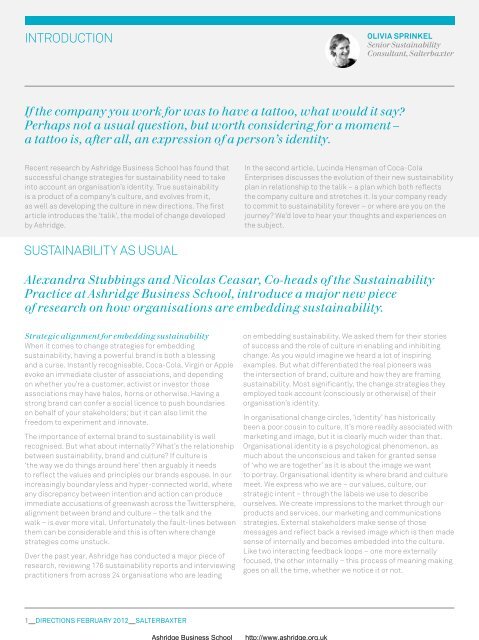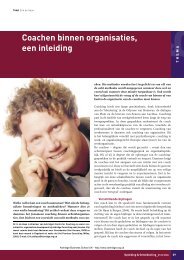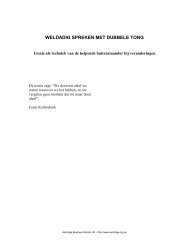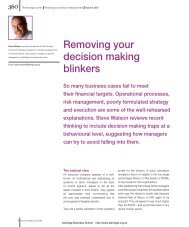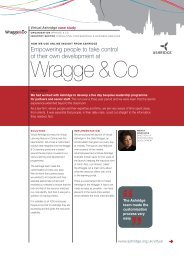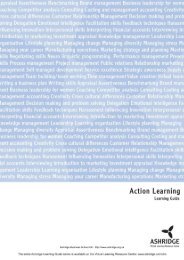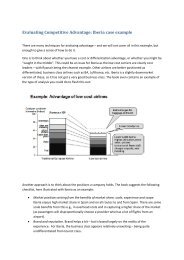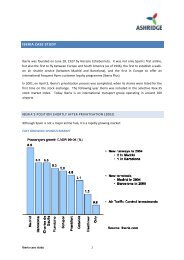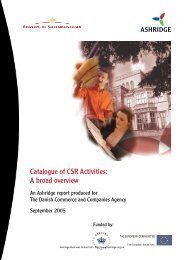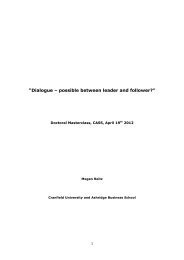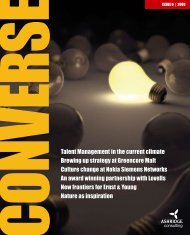Sustainability Forever? Embedding sustainability in your ... - Ashridge
Sustainability Forever? Embedding sustainability in your ... - Ashridge
Sustainability Forever? Embedding sustainability in your ... - Ashridge
Create successful ePaper yourself
Turn your PDF publications into a flip-book with our unique Google optimized e-Paper software.
IntRodUctIon<br />
If the company you work for was to have a tattoo, what would it say?<br />
Perhaps not a usual question, but worth consider<strong>in</strong>g for a moment –<br />
a tattoo is, after all, an expression of a person’s identity.<br />
Recent research by <strong>Ashridge</strong> Bus<strong>in</strong>ess School has found that<br />
successful change strategies for <strong>susta<strong>in</strong>ability</strong> need to take<br />
<strong>in</strong>to account an organisation’s identity. true <strong>susta<strong>in</strong>ability</strong><br />
is a product of a company’s culture, and evolves from it,<br />
as well as develop<strong>in</strong>g the culture <strong>in</strong> new directions. the first<br />
article <strong>in</strong>troduces the ‘talik’, the model of change developed<br />
by <strong>Ashridge</strong>.<br />
SUStAInABILItY AS USUAL<br />
1 DIRECTIONS FEBRUARY 2012 SAlTERBAxTER<br />
In the second article, Luc<strong>in</strong>da Hensman of coca-cola<br />
Enterprises discusses the evolution of their new <strong>susta<strong>in</strong>ability</strong><br />
plan <strong>in</strong> relationship to the talik – a plan which both reflects<br />
the company culture and stretches it. Is <strong>your</strong> company ready<br />
to commit to <strong>susta<strong>in</strong>ability</strong> forever – or where are you on the<br />
journey? We’d love to hear <strong>your</strong> thoughts and experiences on<br />
the subject.<br />
Alexandra Stubb<strong>in</strong>gs and Nicolas Ceasar, Co-heads of the <strong>Susta<strong>in</strong>ability</strong><br />
Practice at <strong>Ashridge</strong> Bus<strong>in</strong>ess School, <strong>in</strong>troduce a major new piece<br />
of research on how organisations are embedd<strong>in</strong>g <strong>susta<strong>in</strong>ability</strong>.<br />
Strategic alignment for embedd<strong>in</strong>g <strong>susta<strong>in</strong>ability</strong><br />
When it comes to change strategies for embedd<strong>in</strong>g<br />
<strong>susta<strong>in</strong>ability</strong>, hav<strong>in</strong>g a powerful brand is both a bless<strong>in</strong>g<br />
and a curse. Instantly recognisable, coca-cola, Virg<strong>in</strong> or Apple<br />
evoke an immediate cluster of associations, and depend<strong>in</strong>g<br />
on whether you’re a customer, activist or <strong>in</strong>vestor those<br />
associations may have halos, horns or otherwise. Hav<strong>in</strong>g a<br />
strong brand can confer a social licence to push boundaries<br />
on behalf of <strong>your</strong> stakeholders; but it can also limit the<br />
freedom to experiment and <strong>in</strong>novate.<br />
the importance of external brand to <strong>susta<strong>in</strong>ability</strong> is well<br />
recognised. But what about <strong>in</strong>ternally? What’s the relationship<br />
between <strong>susta<strong>in</strong>ability</strong>, brand and culture? If culture is<br />
‘the way we do th<strong>in</strong>gs around here’ then arguably it needs<br />
to reflect the values and pr<strong>in</strong>ciples our brands espouse. In our<br />
<strong>in</strong>creas<strong>in</strong>gly boundaryless and hyper-connected world, where<br />
any discrepancy between <strong>in</strong>tention and action can produce<br />
immediate accusations of greenwash across the twittersphere,<br />
alignment between brand and culture – the talk and the<br />
walk – is ever more vital. Unfortunately the fault-l<strong>in</strong>es between<br />
them can be considerable and this is often where change<br />
strategies come unstuck.<br />
over the past year, <strong>Ashridge</strong> has conducted a major piece of<br />
research, review<strong>in</strong>g 176 <strong>susta<strong>in</strong>ability</strong> reports and <strong>in</strong>terview<strong>in</strong>g<br />
practitioners from across 24 organisations who are lead<strong>in</strong>g<br />
<strong>Ashridge</strong> Bus<strong>in</strong>ess School http://www.ashridge.org.uk<br />
Olivia SPr<strong>in</strong>kel<br />
Senior <strong>Susta<strong>in</strong>ability</strong><br />
Consultant, Salterbaxter<br />
on embedd<strong>in</strong>g <strong>susta<strong>in</strong>ability</strong>. We asked them for their stories<br />
of success and the role of culture <strong>in</strong> enabl<strong>in</strong>g and <strong>in</strong>hibit<strong>in</strong>g<br />
change. As you would imag<strong>in</strong>e we heard a lot of <strong>in</strong>spir<strong>in</strong>g<br />
examples. But what differentiated the real pioneers was<br />
the <strong>in</strong>tersection of brand, culture and how they are fram<strong>in</strong>g<br />
<strong>susta<strong>in</strong>ability</strong>. Most significantly, the change strategies they<br />
employed took account (consciously or otherwise) of their<br />
organisation’s identity.<br />
In organisational change circles, ‘identity’ has historically<br />
been a poor cous<strong>in</strong> to culture. It’s more readily associated with<br />
market<strong>in</strong>g and image, but it is clearly much wider than that.<br />
organisational identity is a psychological phenomenon, as<br />
much about the unconscious and taken for granted sense<br />
of ‘who we are together’ as it is about the image we want<br />
to portray. organisational identity is where brand and culture<br />
meet. We express who we are – our values, culture, our<br />
strategic <strong>in</strong>tent – through the labels we use to describe<br />
ourselves. We create impressions to the market through our<br />
products and services, our market<strong>in</strong>g and communications<br />
strategies. External stakeholders make sense of those<br />
messages and reflect back a revised image which is then made<br />
sense of <strong>in</strong>ternally and becomes embedded <strong>in</strong>to the culture.<br />
Like two <strong>in</strong>teract<strong>in</strong>g feedback loops – one more externally<br />
focused, the other <strong>in</strong>ternally – this process of mean<strong>in</strong>g mak<strong>in</strong>g<br />
goes on all the time, whether we notice it or not.


